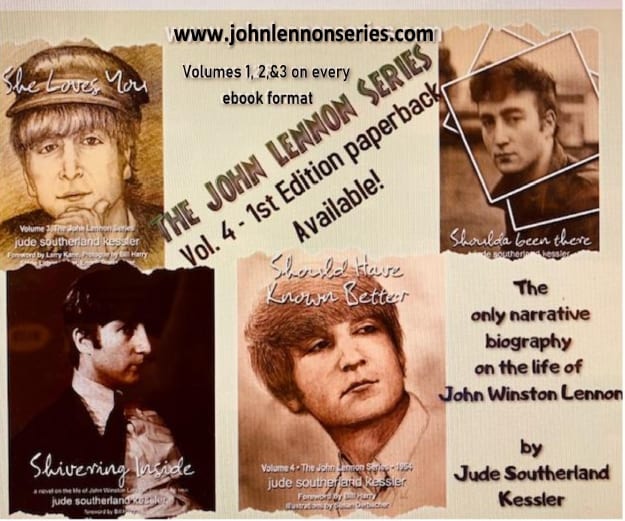by Jude Southerland Kessler
https://www.johnlennonseries.
“If art were to redeem man, it could do so only by saving him from the seriousness of life and restoring him to an unexpected boyishness.” – John Lennon, 1968
John Lennon’s quote on the purpose of art is exquisite and inspiring … the sort of high ideal that bears repeating. Art’s raison d’etre, John says, should be to restore a childlike joy in the world. But wait … does our most beloved art accomplish this? No. In fact, quite the opposite. Frequently, the finest art gives voice to loss, pain, and, to quote Langston Hughes, “dreams deferred.” Great art often conveys deep suffering. In the songs, paintings, poems, sculptures, and books of heralded artists, we regularly discover torn souls.
Indeed, tragedy speaks most eloquently through Michelangelo’s Pietà, the devastating sculpture of Virgin Mary cradling her broken son. And think of wistful Mona Lisa’s remote smile … or that fragile, fleeting moment of friendship before betrayal and violent death in DaVinci’s The Last Supper. Stand in front of Leutze’s vivid depiction of a frightened, but determined, George Washington taking his terrified, young soldiers across the Delaware at midnight, leading them into battle on Christmas Eve. The painting stirs us. We respond to haunting portraits … and to lonely-eyed children. Thomas Gainsborough’s The Blue Boy holds a special meaning because we know that the youth passed away, not long after he was captured on canvas.
In literature, the same holds true. We may enjoy a Shakespeare sonnet, but the anguish of Fields’s Little Boy Blue stays with us. Somehow, we never forget the emotional poems of that invalid child, Robert Louis Stevenson, who dwelt in a world of counterpane, but longed to be up and out of bed. We are drawn to the broken-hearted yearnings of Edgar Allen Poe for a delicate and deceased love, “Annabel Lee.” And the aching poems of social recluse, Emily Dickinson — sheltering herself from pain yet dreaming of a “normal” life — invade our souls. We may smile at the whimsy of an Ogden Nash, but we don’t hold it close.
And then, of course, there’s the music. Sit and listen to the solitary regret inherent in Paul McCartney’s “Yesterday.” Bear the sentimental homesickness in “White Christmas.” And in almost everything ever written by John Lennon — from “If I Fell” to “Not A Second Time” to “Yes It Is” to “In My Life” — your admiring “Ahhh!” will encompass both deep appreciation and deep, empathetic sadness. Beethoven’s “Moonlight Sonata” and “Für Elise” are elegant, but mournful. And who doesn’t love “Softly as I Leave You” or Simon and Garfunkel’s “The Boxer” and “Sounds of Silence” or the Moody Blues’ poignant “Nights in White Satin?” We may get up and dance to “Blue Suede Shoes,” but it’s “Can’t Help Falling in Love” that we never forget.
Several years ago, my sister-in-law — whose pre-teen son was experiencing depression after a classmate had committed suicide — e-mailed me, asking for a list of happy books that her son’s classroom could read. They had been studying A Separate Peace, and she thought (and I agreed with her) that it was an excellent book, but a tremendously sad one as well. So, I began combing through lists of the best books for teenagers, and found that most of them were tinged with sorrow. Anne Frank’s Diary of a Young Girl is inspiring, but in the end, tragic. To Kill a Mockingbird touches the heart with the pain of injustice. Little Women is a treasure, but one needs to read Alcott’s classic and lovely story with a tissue in hand.
The Adventures of Huckleberry Finn offers some hilarious moments, but at its core lies the anguish of Huck’s tortured decision about “going to hell” to save an escaped slave. So many wonderful books dwell upon the theme of isolation and loneliness: The Red Badge of Courage, Catcher in the Rye, Of Mice and Men, Frankenstein, The Great Gatsby, The Scarlet Letter, and yes, even (for younger children) The Giving Tree and The Velveteen Rabbit. It seems our finest books express our fullest grief.
In art that sighs for us, we find solace. In shared misery, as the old saying goes, we find company. In songs and poems and paintings and music that express our grief better than we can express it, we find understanding.
I know that in the opening quote above, John Lennon was aspiring to write songs of childlike joy, but (like John Phillip Sousa, who desperately longed to write lullabies but always ended up writing marches), John Lennon always gravitated to a much darker place. His art never “restored an unexpected boyishness” to the world or to himself. But in their similarity to our own struggles, Lennon’s music always comforted us.
So … what does all of this have to do with those of us here in Louisiana in 2021? Well, as we emerge into a new year after a pandemic and its horrible losses, after hurricanes and their devastation, after a burgeoning economy crumbled under destructive circumstances, I wonder if we might find a way to “take a sad song and make it better”? I wonder if those out there of you reading this blog might try to take the pain of 2020 and transform it into a book, poem, painting, dance, song, film, or new organization to help others … if, from your pain, you might create something especially beautiful. Rarely have Louisianians been so low, but that is when we humans are most inspired! Across this great state of Louisiana, mightn’t we use this moment to say something, sing something, build something or do something that will last forever?
Just as the legendary Rumpelstiltskin wove ordinary straw into skeins of pure gold, might not THIS be the moment to create your masterpiece? “If art is to redeem man …” then, give your feelings a voice. Let’s geaux.






















